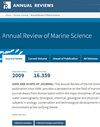揭示海洋溶解有机质的结构空间
IF 18.9
1区 地球科学
Q1 GEOCHEMISTRY & GEOPHYSICS
引用次数: 0
摘要
海洋溶解有机物(DOM)是地球上最复杂的外代谢组之一,在海洋碳循环和长期封存中起着核心作用。尽管DOM具有重要的生物地球化学意义,但其分子复杂性长期以来一直挑战着其分析表征。在这里,我们回顾了DOM结构解析分析技术的最新进展。除了光谱方法外,我们还专注于液相色谱-串联质谱法和离子迁移谱法,因为这些技术可以提供前所未有的分子水平的DOM组成洞察。通过将高分辨率分析技术与计算管道相结合,研究人员现在能够解决以前模糊的分子结构,这有可能完善DOM循环及其与微生物群落相互作用的模型。结构解析方法的持续创新对于揭示海洋DOM的分子复杂性和理解其对全球生物地球化学过程的影响至关重要。本文章由计算机程序翻译,如有差异,请以英文原文为准。
Uncovering the Structural Space of Marine Dissolved Organic Matter
Marine dissolved organic matter (DOM) represents one of Earth's most complex exometabolomes, playing a central role in marine carbon cycling and long-term sequestration. Despite its biogeochemical importance, the molecular complexity of DOM has long challenged its analytical characterization. Here, we review recent advancements in structure-resolved analytical techniques for DOM. In addition to spectroscopic methods, we focus on liquid chromatography–tandem mass spectrometry and ion mobility spectrometry, as these technologies can provide unprecedented molecular-level insights into DOM composition. By integrating high-resolution analytical techniques with computational pipelines, researchers are now able to resolve previously obscured molecular structures, which has the potential to refine models of DOM cycling and its interactions with microbial communities. Continued innovation in structure-resolved methodologies will be essential for unraveling the molecular complexity of marine DOM and understanding its implications for global biogeochemical processes.
求助全文
通过发布文献求助,成功后即可免费获取论文全文。
去求助
来源期刊

Annual Review of Marine Science
地学-地球化学与地球物理
CiteScore
33.60
自引率
0.60%
发文量
40
期刊介绍:
The Annual Review of Marine Science, published since 2009, offers a comprehensive overview of the field. It covers various disciplines, including coastal and blue water oceanography (biological, chemical, geological, and physical), ecology, conservation, and technological advancements related to the marine environment. The journal's transition from gated to open access through Annual Reviews' Subscribe to Open program ensures that all articles are available under a CC BY license, promoting wider accessibility and dissemination of knowledge.
 求助内容:
求助内容: 应助结果提醒方式:
应助结果提醒方式:


